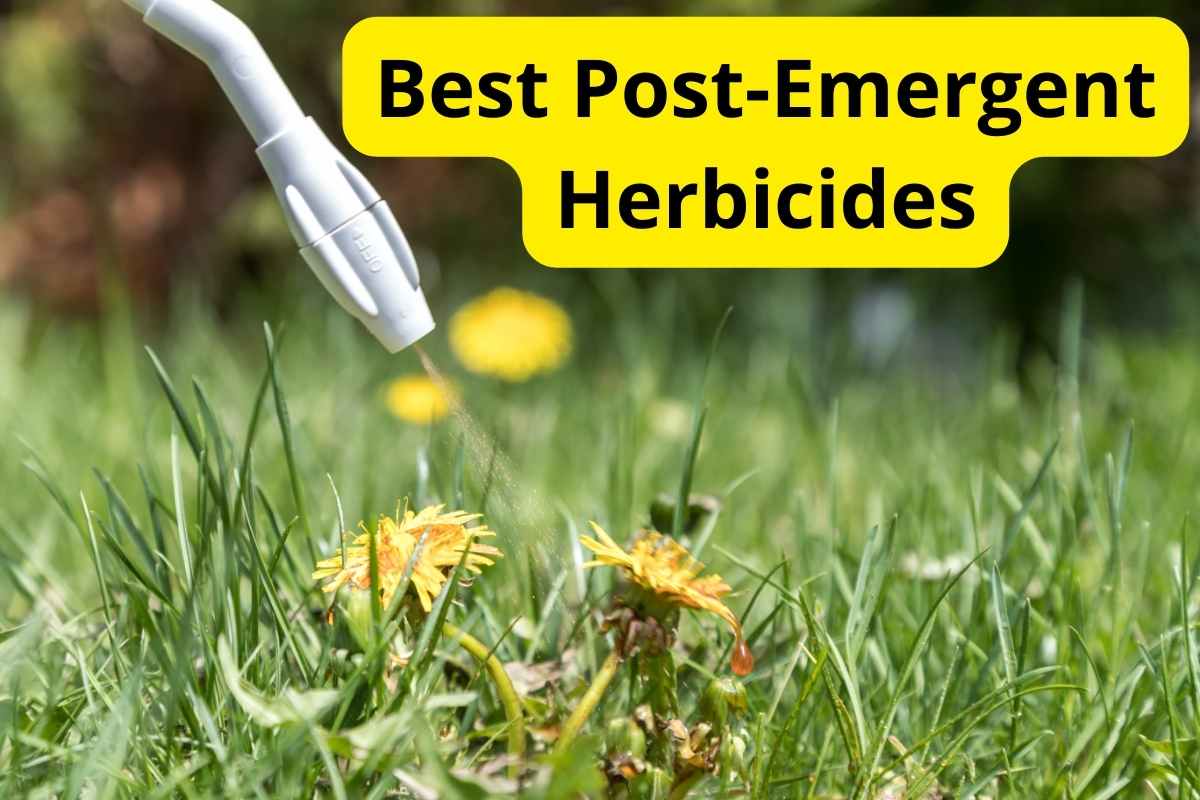
Spring is in the air, so your yard needs special care to kill pesky lawn weeds. We searched the shelves of Home Depot, Lowe’s, Amazon, and Walmart to find the best post-emergent herbicides.
Our list includes chemical and organic weed killers for lawns, patios, and garden beds. We carefully compared each herbicide’s ingredients, application, and cost to find the best ones. Our weed killer reviews and buying guide make it easy to pick the best post-emergent product for your yard.
Our Top Picks
1. Gordon’s Trimec – Best for Cool-Season Grass
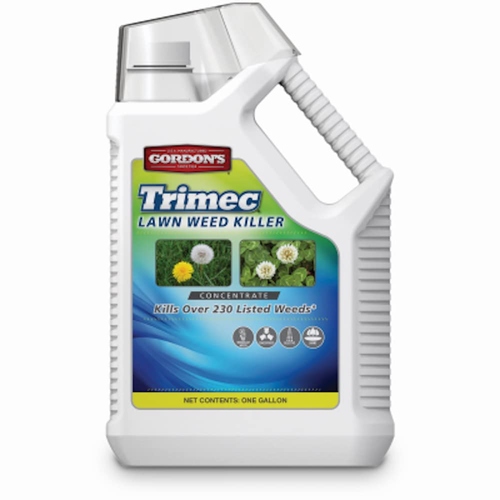
Gordon’s Trimec
Concentrated 3-way herbicide blend, kills 230+ broadleaf weeds, covers 32000-64000 sq.ft., tailored for northern and southern lawns.
Gordon’s Trimec is effective and affordable. It’s the best lawn-safe killer of enduring broadleaf weeds like dandelion, plantains, and hemlock. Combining the power of three herbicides, Trimec slays over 230 lawn weeds. Although initially formulated for cool-season grass, it’s safe for some warm-season varieties.
How fast does it work? You may see improvement within a day. It continues working for up to four weeks.
Where can you use it? It treats residential lawns with the following turf:
- Kentucky bluegrass
- Bermuda
- Perennial ryegrass
- Fescues
- Other cool-season grasses
What’s the application rate? For cool-season grass, mix 4 fl. oz. of product with 1 gallon of water to cover 1,000 square feet. For warm-season grass, mix 2 fl. oz. of product with 1 gallon of water to cover 1,000 square feet.
Specifications
- Active ingredients: 2, 4-D, Mecoprop, Dicamba
- Application: Sprayer
- Coverage: 32,000 to 64,000 sq. ft.
- Form: Liquid
- Herbicide type: Selective, Systemic
- Size: 1 gal.
- Targeted weeds: 230+ broadleaf weeds
Pros and Cons
| What we liked | What we didn’t like |
| ✓ Very effective against 230+ lawn weeds ✓ Long-lasting formula ✓ Affordable ✓ Safe on cool-season grass | ✗ Dogs and cats are sensitive to it ✗ It’s toxic to aquatic life ✗ Not safe on some warm season grass |
2. Southern Ag 2,4-D Amine – Best for Warm-Season Grass
Southern Ag 2,4-D Amine
Economical herbicide: 1-4 pints/acre. Controls broadleaf weeds, woody plants. Versatile: turf, pastures, rangeland, ditch banks, fences.
Southern Ag 2,4-D Amine quickly kills bothersome broadleaf weeds, including smartweed and wild garlic. Yet, it has little effect on most grasses. As a Southerner, I appreciate how gentle it is on herbicide-sensitive warm-season turf, such as St. Augustinegrass. Additionally, it’s non-toxic to bees and other beneficial insects.
How fast does it work? We often see improvements within two days. It continues working for up to two weeks.
Where can you use it? It treats lawns, pastures, golf courses, parks, small grains, and corn.
What’s the application rate? Mix 2 to 3 tablespoons of product with 3 to 5 gallons of water to cover 1,000 square feet.
Specifications
- Active ingredients: 2,4-D
- Application: Sprayer (fan type nozzle preferred)
- Coverage: 20,000 sq. ft.
- Form: Liquid
- Herbicide type: Selective,Systemic
- Size: 32 oz.
- Targeted weeds: Non-grassy broadleaf weeds and woody plants
Pros and Cons
| What we liked | What we didn’t like |
| ✓ Affordable ✓ Safe on southern lawns ✓ Non-toxic to honeybees ✓ Very effective against non-grassy broadleaf weeds | ✗ Dogs and cats are sensitive to it ✗ Not effective on grassy weeds |
3. Earth’s Ally Weed and Grass Killer – Best for Garden Beds
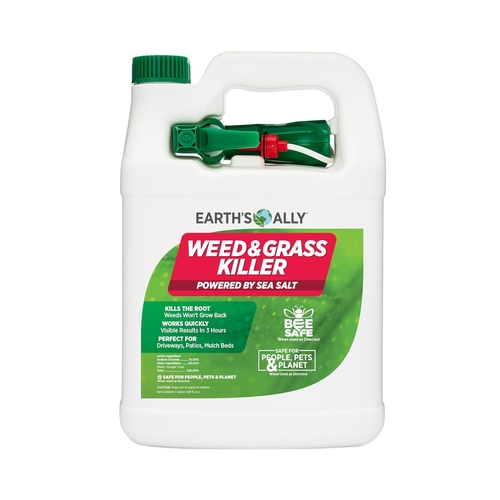
Earth’s Ally Weed and Grass Killer
Earth’s Ally: Non-selective, pet-safe herbicide with sea salt power, kills weeds like broadleaf, crabgrass, dandelion. Visible results in 3 hours.
Earth’s Ally Weed and Grass Killer is our favorite product for spot-treating pavement cracks and preparing garden beds. The salt-based solution comes ready-to-use in a trigger spray bottle. Using dehydration, it controls broadleaf and grassy weeds, including crabgrass, dandelion, and clover. It’s eco-friendly and safe for children, pets, and pollinators.
How fast does it work? Plants noticeably decline in about 3 hours and die within 10 days.
Where can you use it? It treats driveways, patios, and vegetable/landscape beds. We don’t advise using it for lawn weed control, even on salt-tolerant varieties.
What’s the application rate? No mixing is required. It comes ready-to-use.
Specifications
- Active ingredient: Sodium Chloride
- Application: Trigger spray bottle
- Coverage: 300 sq. ft.
- Form: Liquid
- Herbicide type: Organic, Non-selective, Contact
- Size: 1 gal.
- Targeted weeds: Broadleaf and grassy weeds
Pros and Cons
| What we liked | What we didn’t like |
| ✓ Organic ✓ No mixing ✓ Safe near edibles ✓ Non-toxic to honeybees ✓ Safe for children and pets ✓ No additional equipment needed ✓ Effectively kills grassy and broadleaf weeds | ✗ Expensive ✗ Doesn’t kill as many plants as RM43 |
4. RM43 Total Vegetation Control – Best for Complete Annihilation
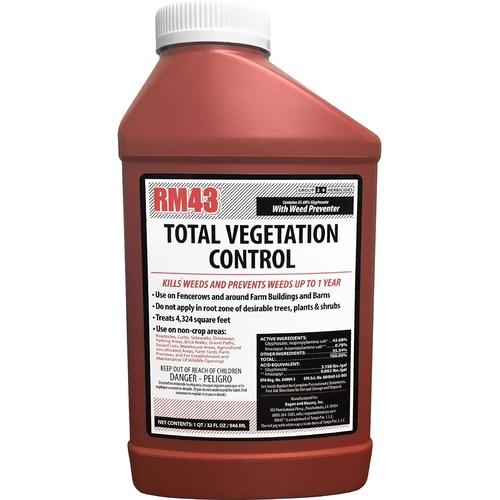
RM43 Total Vegetation Control
Versatile herbicide: Prevents vegetation for up to 1 year. Spot control for brush, vines, weeds along fences, roadsides.
The most effective non-selective weed killer is RM43 Total Vegetation Control. It kills most vegetation, including turfgrass, brush, and invasive vines. Additionally, it prevents plants from growing for up to one year.
The concentrated formula contains two potent herbicides and a surfactant. Like Roundup, it quickly eliminates annual grasses, but RM43 beats Roundup’s ability to kill many broadleaf and woody plants. It’s great for large areas, such as sites that need clearing to build a deck or patio. Alternatively, it can spot-treat pavement, patios, and gravel.
How fast does it work? Vegetation starts to succumb in 2 to 3 days, and most plants die within two weeks.
Where can you use it? It treats weeds on sidewalks, driveways, fence rows, vacant lots, and construction sites.
What’s the application rate? To treat 1,000 square feet, mix 7.4 fl. oz. of product with 1 to 10 gallons of water.
Specifications
- Active ingredient: Glyphosate, Imazapyr
- Application: Sprayer
- Coverage: 4,324 sq. ft.
- Form: Liquid
- Herbicide type: Non-selective, Systemic
- Size: 32 oz.
- Targeted weeds: Kills most plants, including grass, weeds, brush, vines and trees
Pros and Cons
| What we liked | What we didn’t like |
| ✓ Effective against just about all vegetation ✓ Prevents new plants from growing ✓ Works quickly ✓ Long lasting results ✓ Easy to mix and apply ✓ Affordable | ✗ Not good for areas with desirable lawns or landscaping ✗ Can’t grow anything in the area for one year ✗ Because it’s long lasting, it’s highly pollutant ✗ Harms beneficial bacteria in soil |
5. Captain Jack’s Lawnweed Brew – Best Organic Lawn Weed Killer
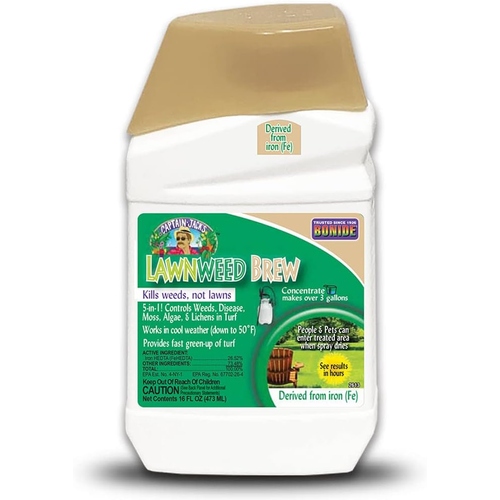
Captain Jack’s Lawnweed Brew
Controls weeds and disease including dandelion, moss, algae, clover. Quick results within hours. Safe for grass. Derived from iron.
Captain Jack’s Lawnweed Brew is an organic herbicide that’s gentle on grass. Its key ingredient, iron HEDTA, controls many broadleaf weeds. Dr. Dave Gardner, a professor of turfgrass science at OSU, recommends using iron HEDTA to control dandelion, white clover, ground ivy, and plantains. In addition to killing weeds, Captain Jack targets moss, algae, and diseases.
How fast does it work? In just a few hours we noticed weeds deteriorate. You may have to reapply the product 3 to 4 weeks after the initial treatment. A Cornell University study found that henbit, ajuga, white clover, oxalis and motherwort died after one treatment. Other weeds took two to three treatments.
Where can you use it? Just about any cool-season or warm-season grass, except bentgrass.
What’s the application rate? Mix 5 ounces of product with 1 gallon of water. It takes 2.5 to 10 gallons of mixed solution to treat 1,000 square feet.
Specifications
- Active ingredient: Iron HEDTA
- Application: Backpack, compression, or knapsack sprayer
- Coverage: 2,400 sq. ft.
- Form: Liquid
- Herbicide type: Organic, Selective, Contact
- Size: 32 oz.
- Targeted weeds: Broadleaf weeds, moss, algae
Pros and Cons
| What we liked | What we didn’t like |
| ✓ Organic ✓ Works quickly ✓ Safe on most grass ✓ Non-toxic to honeybees ✓ Safe to reseed after 24 hours ✓ Effectively kills many lawn weeds ✓ Controls moss and algae ✓ Controls lawn diseases including dollar spot, rust, snow mold | ✗ Expensive ✗ Many weeds need multiple treatments ✗ Sometimes it temporally discolors grass ✗ Not safe on bentgrass |
6. Quali-Pro Quinclorac 75 DF – Best Crabgrass Killer
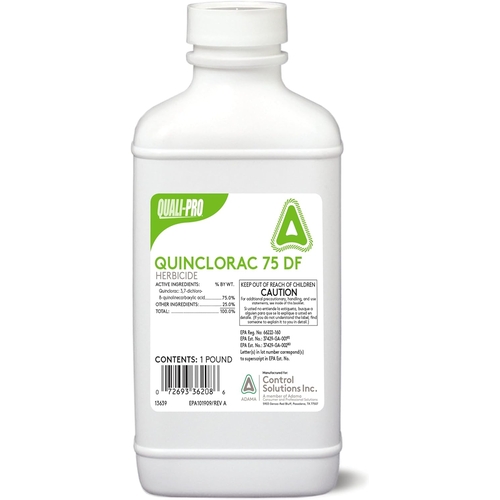
Quali-Pro Quinclorac 75 DF
Ideal for commercial and residential turfgrass, golf courses, sports fields, and sod farms. Effective against various weeds. Contains Quinclorac 75%.
Quali-Pro Quinclorac 75 DF is the best crabgrass killer. It also controls clover, dollarweed, Kikuyu, and many other grassy and broadleaf weeds. Quinclorac is safe on several grass types but isn’t for everyone—warm-season turf such as Bahiagrass, St. Augustine, and centipede is susceptible to severe damage.
How fast does it work? Noticeable changes occur within a few days. It continues working for up to 2 weeks.
Where can you use it? It treats residential and commercial lawns, golf courses, sports fields, and sod farms with the following types of turf:
- Bermuda
- Kentucky bluegrass
- Buffalo
- Fescue
- Ryegrass
- Zoysiagrass
What’s the application rate? Mix 1 tablespoon of product with 1 gallon of water to cover 1 acre. A surfactant is required.
Specifications
- Active ingredients: Quinclorac
- Application: Sprayer
- Coverage: 43,560 sq. ft.
- Form: Water-soluble
- Herbicide type: Selective, systemic
- Size: 1 lb.
- Targeted weeds: Broadleaf and grassy weeds
Pros and Cons
| What we liked | What we didn’t like |
| ✓ Very effective against crabgrass and other grassy weeds ✓ Effective on some broadleaf weeds ✓ Kills mature crabgrass and clover ✓ Highly concentrated ✓ Safe on many popular turf grasses | ✗ Doesn’t work as well as 2,4-D and Trimec on some broadleaf weeds ✗ Harmful to most warm-season turf ✗ Toxic to aquatic life ✗ Cumbersome to mix |
7. Sedgehammer Plus Turf Herbicide – Best Nutsedge Killer
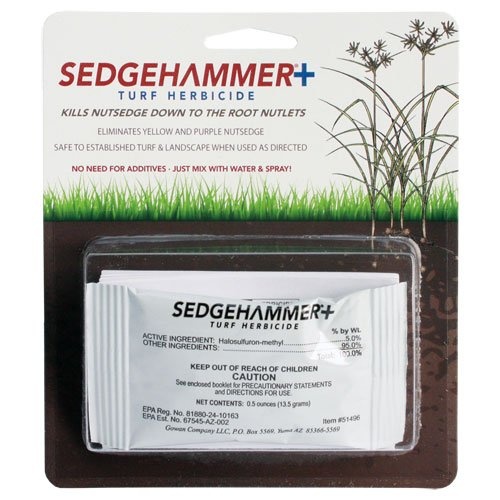
Sedgehammer Plus Turf Herbicide
Sedgehammer Herbicide: Contains 13.5g Halosulfuron-methyl (5%). Ideal for established lawns, ornamental turf, and various non-crop sites. Easy application.
The best nutsedge slayer is Sedgehammer Plus Turf Herbicide. It controls purple and yellow nutsedge, kyllinga, and horsetail but won’t harm most turf. It’s a potent product that penetrates plants within two days. Nutsedge will slowly deteriorate and die within weeks. Mixing is made simple because Sedgehammer comes in packets that already include a surfactant.
How fast does it work? Nutsedge starts turning brown within two weeks and dies within 4 weeks. One application is typically enough, but some situations may require additional applications.
Where can you use it? It treats established lawns, ornamental turfgrass, landscaping, parks, and sports fields.
What’s the application rate? Mix 1 packet (1.33 oz.) with 1 gallon of water to cover 1,000 square feet.
Specifications
- Active ingredient: Halosulfuron-methyl
- Application: Sprayer
- Coverage: 1,000 sq. ft.
- Form: Water-soluble
- Herbicide type: Selective, Systemic
- Size: 27.22 grams
- Targeted weeds: Sedges including purple and yellow nutsedge
Pros and Cons
| What we liked | What we didn’t like |
| ✓ Very effective against nutsedge ✓ Easy to measure and mix ✓ Safe for most grass types ✓ Controls kyllinga and horsetail | ✗ Doesn’t kill many broadleaf weeds ✗ Expensive |
8. Scotts WeedEx Southern – Best Granular Weed Killer
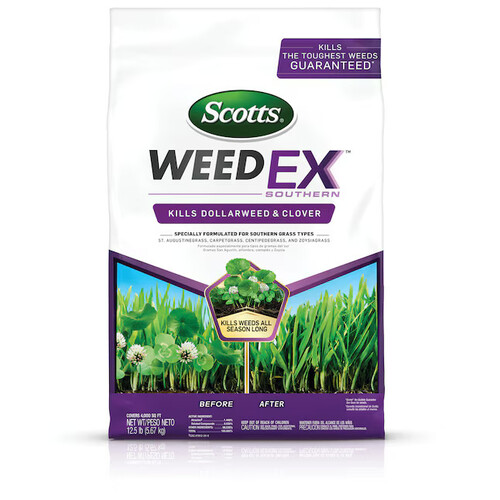
Scotts WeedEx Southern
Scotts® WeedEx™ Southern: Kills tough Southern weeds like dollarweed and clover. Controls over 25 listed weeds. Safe for specific grass types.
Our favorite granular post-emergent herbicide is Scotts WeedEx Southern. It controls over 25 common lawn weeds, including dollarweed, clover, oxtail, and chickweed. It also kills winter weeds such as henbit and evening primrose. The granules are easy to apply and safe on sensitive southern lawns.
How fast does it work? It takes 2 to 6 weeks to work.
Where can you use it? It treats lawns with the following warm-season grasses:
- St. Augustine (including Floratam)
- Centipedegrass
- Zoysiagrass
- Carpetgrass
What’s the application rate? The granules don’t need mixing, but be sure to water the lawn after application. Apply with a broadcast spreader set on 5 or a drop spreader with an 11.5 setting.
Specifications
- Active ingredient: Atrazine
- Application: Spreader
- Coverage: 4,000 sq. ft.
- Form: Granular
- Herbicide type: Selective, Systemic
- Size: 12.5 lb.
- Targeted weeds: Annual grasses and broadleaf weeds
Pros and Cons
| What we liked | What we didn’t like |
| ✓ Safe on sensitive warm season grasses ✓ Effective on over 25 common lawn weeds ✓ Prevents new weeds from sprouting ✓ Works on winter weeds ✓ Easy to apply evenly | ✗ Not for cool-season grass ✗ Treats less weeds than most products ✗ Toxic to aquatic life |
Buyer’s Guide
To purchase the best weed killer, please consider the following:
Types of Herbicides
Herbicides come in two major varieties:
- Post-emergent herbicides kill weeds after they sprout. If you want to get rid of visible weeds, you’re in the right place.
- Pre-emergent herbicides prevent weeds from germinating. If you want to attack weeds before they sprout, you need the best weed preventers.
When selecting a type of post-emergent weed killer, you have the following choices:
- Liquid vs. Granular: Liquid and granular herbicides each have advantages, so the decision often boils down to preference. Liquids tend to work better, but it’s easier to apply granules evenly.
- Selective vs. Non-selective: Selective herbicides target specific weeds, and non-selective herbicides can kill anything. Stick with selective products on your lawn so the grass doesn’t die.
- Systemic vs. Contact: Contact herbicides kill what they touch. In contrast, plants absorb systemic herbicides, so the poison circulates through its vascular system. Systemic products take longer to work but do a thorough job. Contact products tend to be non-selective and are best for spot treatments, such as growth through a sidewalk crack.
- Chemical vs. Organic: Many organic herbicides kill broadleaf weeds, but they aren’t good at eliminating crabgrass and other grassy weeds. Chemical herbicides are more effective, but they harm the ecosystem.
Chemical Ingredients
Selective post-emergent herbicides include:
- 2,4-D systemically kills broadleaf weeds. When appropriately used, it’s safe on turfgrass, gardens, and farms. Weeds absorb it through their root system, causing a cancer-like condition that kills the plant within 2 weeks.
- Atrazine is a pre- and post-emergent product that systemically kills broadleaf weeds and grasses.
- Dicamba kills annual and perennial weeds, including broadleaf and woody plants. It works on lawns, crops, and pastures, typically within 2 to 3 weeks.
- Halosulfuron-methyl is a systemic herbicide that kills nutsedge in three to four weeks.
- Monosodium Methanearsonate (MSMA) kills grassy and broadleaf weeds. It’s arsenic-based and the EPA warns it can contaminate drinking water.
- Quinclorac kills broadleaf and grassy weeds, including crabgrass. It typically takes 10 to 14 days to work.
- Triclopyr kills broadleaf weeds and woody plants in lawns and landscaping. It’s a systemic herbicide that takes up to three weeks to work.
Non-selective post-emergent herbicides include:
- Glufosinate is a fast-acting contact herbicide that kills plants within a few days. It’s the best non-selective herbicide for many broadleaf weeds.
- Glyphosate kills most vegetation within 14 days. It controls annual grasses better than Glufosinate.
- Imazapyr is a systemic herbicide that works well in wet climates. It takes a few weeks to several months to kill perennial grasses, broadleaf herbs, woody plants, and aquatic/wetland vegetation.
Organic Ingredients
Organic herbicides typically work on contact. Each ingredient’s effectiveness varies from plant to plant, but most natural weed killers are considered non-selective. Some are safe on turfgrass or landscaping, as indicated on the product label.
Organic weed killers include:
- Ammonium nonanoate is a fatty acid in plants and animals. It kills some plants, such as grass and vines, within hours.
- Caprylic acid is a fatty acid from palm oil, coconut oil, or milk. It works best on small weeds and starts killing things within hours.
- Citrus oil is a degreaser that kills broadleaf weeds, crabgrass, and other weeds.
- Iron-HEDTA selectively targets broadleaf weeds and algae.
- Salt (sodium chloride) dehydrates and eliminates broadleaf and grassy weeds.
- Vinegar typically kills plants within a week. It’s often mixed with citric acid to increase its effectiveness.
Types of Weeds
The table below lists the post-emergent products we recommend by weed type.
| Weed | Best products |
| Broadleaf plantain | 2,4-D Amine, Gordon’s Trimec, Captain Jack’s, RM43 |
| Bull thistle | 2,4-D Amine, Gordon’s Trimec, Captain Jack’s, RM43 |
| Chickweed | 2,4-D Amine, Gordon’s Trimec, Quali-Pro Quinclorac, Captain Jack’s, Scotts WeedEx, RM43, Earth’s Ally Weed and Grass Killer |
| Clover | Gordon’s Trimec, Quali-Pro Quinclorac, Captain Jack’s, Scotts WeedEx, RM43, Earth’s Ally Weed and Grass Killer |
| Crabgrass | Quali-Pro Quinclorac, RM43, Earth’s Ally Weed and Grass Killer |
| Dandelion | 2,4-D Amine, Gordon’s Trimec, Quali-Pro Quinclorac, Captain Jack’s, Scotts WeedEx, RM43, Earth’s Ally Weed and Grass Killer |
| Dollarweed | Gordon’s Trimec, Quali-Pro Quinclorac, Scotts WeedEx, RM43 |
| Hemlock | Gordon’s Trimec, RM43 |
| Kudzu | RM43 |
| Nutsedge | Sedgehammer |
| Poa Annua (annual bluegrass) | RM43 |
| Poison ivy | 2,4-D Amine, Gordon’s Trimec, RM43 |
| Smartweed | 2,4-D Amine, Gordon’s Trimec, RM43 |
| Wild onion | 2,4-D Amine, Gordon’s Trimec, RM43 |
Grass Type
Most turf herbicides are safe on cool-season grasses. However, homeowners with warm-season grasses, such as St. Augustine and centipede, must be more careful. Always read the product label to ensure your grass type is listed as safe, and only use the herbicide as directed.
Prices
Most post-emergent herbicides cost $10 to $140, but DIY weed control prices depend on area coverage and weed killer type. The table below shows the average cost per 1,000 square feet of post-emergent products by herbicide type.
| Type | Average cost / 1,000 sq. ft. |
| All post-emergent | $2.75 |
| Selective | $2.10 |
| Non-selective | $9.20 |
| Organic | $12.70 |
FAQs About Post-Emergent Herbicides
How Do You Apply Post-Emergent Herbicide?
To control weeds, read the product’s directions. Carefully measure each herbicide application and distribute the weed killer evenly. Before applying post-emergent weed killer, also consider the following:
- When to apply: Apply to weeds that have sprouted during the growing season. Most weeds germinate early spring through summer.
- How to apply liquid herbicides: Apply liquids with a sprayer. Most are concentrated and thus mixed with water, but some come ready to use. Ready-to-use products typically come in packaging that has a trigger sprayer. Some concentrated formulas come in packaging that attaches to a garden hose for easy application.
- How to apply granular herbicides: Apply granules with a drop or broadcast spreader. We found the best spreaders for evenly applying granular products.
- When to use a surfactant: Liquid products sometimes need it to spread properly. Most liquid contact weed killers need a surfactant, but some products already have one. Read the application instructions to be sure.
Does Corn Gluten Meal Kill Weeds?
Corn gluten meal is a pre-emergent pesticide. It doesn’t kill weeds after they sprout, but it prevents grassy and broadleaf lawn weeds, including crabgrass. It also feeds lawns slow-release nitrogen, so many homeowners use CGM as a natural weed and feed.
How do you make homemade weed killer?
Using our weed killer recipes, you can make non-selective, post-emergent, contact herbicides from the following ingredients:
- Vinegar
- Lemon juice
- Salt
- Dish soap
When to Call a Lawn Treatment Pro
Controlling lawn weeds doesn’t have to be complicated. Before you spend a heap of cash on fancy equipment and pungent products, it’s essential to consider all your options. LawnStarter connects you with affordable and insured local lawn treatment pros.
We only work with qualified contractors who apply treatments safely and effectively. In addition to weed control, our pros handle lawn mowing, bush trimming, and over 30 other outdoor services. It only takes a moment to get an online quote and schedule services, so your lawn will look lush in no time.
References:
- “Do Granular Herbicide Applications Effectively Control Broadleaf Weeds in Turf?.” Turfgrass Science. Purdue University.
- Chinery, David et al. (2012). “Examination of a new iron-based herbicide for broadleaf weed management.” Cornell University Library
- Gardner, Dr. Dave. (2019, March 13). “Organic Vs Synthetic Herbicides for Athletic Field Weed Management.” Sports Turf Management: Research, Education & Outreach. College of Food, Agriculture, and Environmental Sciences. The Ohio State University
- “Monosodium Methanearsonate (MSMA), an Organic Arsenical.” Ingredients Used in Pesticide Products. U.S. Environmental Protection Agency
- Pena, Marco. (2021, January 27). “Contact Herbicides.” Arizona Pest Management Center. The University of Arizona
- Ruuskanen, Suvi et al. (2022, October 13). “Ecosystem consequences of herbicides: the role of microbiome.” PubMed. National Library of Medicine. National Institutes of Health
- Smith-Fiola, Deborah et al. (2022, May 2). “Iron-based Herbicides: Alternative Materials for Weed Control in Landscapes and Lawns.” University of Maryland Extension
- “Weed Management: Chemical.” Your Florida Lawn: Residential Landscapes. Turfgrass Science Program. Institute of Food and Agricultural Sciences. University of Florida
LawnStarter participates in the Amazon Services LLC Associates Program and other retailer affiliate programs. LawnStarter may earn revenue from products promoted in this article.
Main Image Credit: Onfokus / Canva Pro / License wih Text Overlay using Canva Pro
![12 Best Weed Killers of 2025 [Reviews] spraying weed killers alongside wall with text overlay on it](https://www.lawnstarter.com/blog/wp-content/uploads/2023/07/Best-Weed-Killers.jpg)
![11 Best Weed Killers for Flower Beds of 2025 [Reviews] spraying weed killer in the garden with text overlay on it](https://www.lawnstarter.com/blog/wp-content/uploads/2023/07/Best-Weed-Killers-for-Flower-Beds.jpg)
![7 Best Weed and Feed Products of 2025 [Reviews] green lawn seeding spreader with text overlay on it](https://www.lawnstarter.com/blog/wp-content/uploads/2023/10/Best-Weed-and-Feed-Prodcuts.jpg)
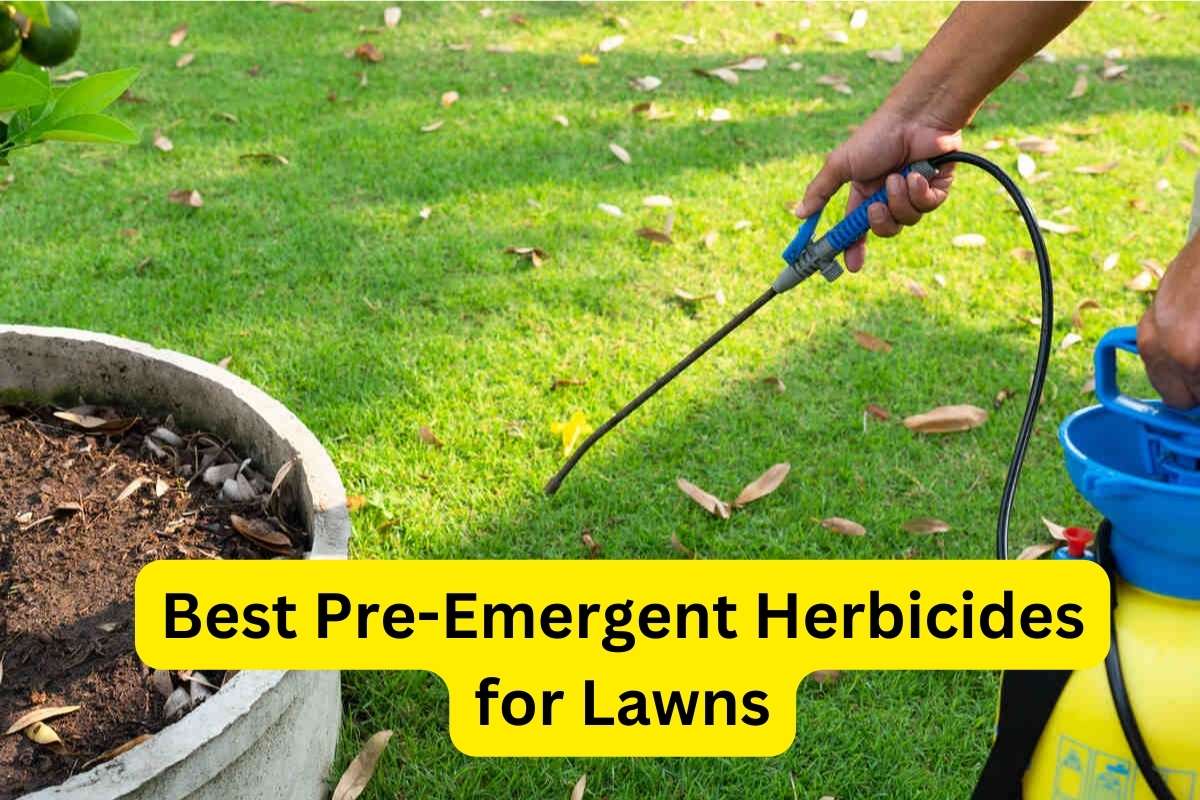
![7 Best Fertilizers for St. Augustinegrass in 2025 [Reviews] St. Augustinegrass in a lawn with text overlay on it](https://www.lawnstarter.com/blog/wp-content/uploads/2024/01/Best-Fertilizers-for-St.-Augustinegrass-3.jpg)